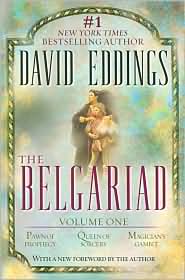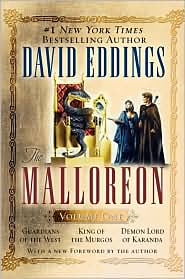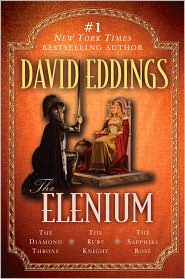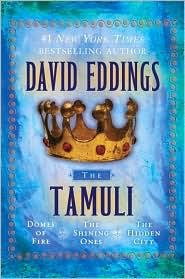Throwback Thursday: David Eddings, Fantasy Gateway Drug
 The Belgariad was my gateway drug into fantasy fiction. As a pre-teen, I was already into sci-fi, but epic fantasy wasn’t something that interested me much. I owe finding it at all to a fortunate case of peer pressure: As middle school girls will, I navigated into a new group of friends, and one of them gave me a copy of Pawn of Prophecy, insisted I read it. Never has peer pressure had a happier outcome. I was instantly hooked on these stories of flawed heroes, devious villains, and epic quests.
The Belgariad was my gateway drug into fantasy fiction. As a pre-teen, I was already into sci-fi, but epic fantasy wasn’t something that interested me much. I owe finding it at all to a fortunate case of peer pressure: As middle school girls will, I navigated into a new group of friends, and one of them gave me a copy of Pawn of Prophecy, insisted I read it. Never has peer pressure had a happier outcome. I was instantly hooked on these stories of flawed heroes, devious villains, and epic quests.
The Belgariad, Volume 1: Pawn of Prophecy, Queen of Sorcery, Magician's Gambit
The Belgariad, Volume 1: Pawn of Prophecy, Queen of Sorcery, Magician's Gambit
Paperback
$19.49
$22.00
The Belgariad stretches for five books, and I quickly devoured them and searched for more from the author, this David Eddings (it was only later I learned that equal credit is due to his wife and co-author, Leigh, whose name wasn’t added to the front covers of his novels until much later; it feels wrong not to give her due credit here.)
The Eddings’ enduring appeal rests on a few key things. The books consciously follow Tolkien, but handle it smartly, jiggling the underlying structure of The Lord of the Rings for their own purposes. The Belgariad sets us up with all the familiar comforts of the genre. Powerful magical object? Check. Unlikely, everyman hero? Check. Wizened wizards, brave warriors, and a quest to save the world? Check, check, and check. But it doesn’t stop there. Long before George R.R. Martin started messing with our heads and breaking our hearts with his refusal to bend to genre expectations (or allow a protagonist to make it through the story alive), David and Leigh Eddings were tweaking the archetypical storytelling beats that Tolkien laid down. They did it with plot and structure, but most especially with characters.
The plot sounds typical: Garion, a hero of the Luke Skywalker school of “normal farm boy, but actually a secret prince” variety, goes on a quest with his faithful companions to recover the Orb of Aldur, which has been stolen. The Orb is a sacred stone with power that can only be unleashed by descendants of his family. They need it to defeat Kal Torak, a devious god. Torak tries to tempt Garion to his side; he resists. Evil is defeated. The heroes return home.
But though our hero is an everyman, there’s a lot more talk about how awkward and gangly he is, rather than how idealistic and pure.There’s that magical object, but this time there are living gods with some serious personalities wrapped up in its fate, not just a disembodied eye. There are wizened wizards, but they’re crotchety old men who curse like sailors, with an endless store of colorful insults. There’s even a disreputable scoundrel (Silk, my favorite, always and forever!) to help out with some of the less noble, but no less necessary, aspects of the quest, something Grandaddy Tolkien had less time for. This cast of characters fills the epic formula vibrant new life, cocking a raised eyebrow at our expectations and stopping to consider the day-to-day aspects of fantasy life that characters must tackle whether on a quest or not, no matter how lofty their aims might be.
The Belgariad stretches for five books, and I quickly devoured them and searched for more from the author, this David Eddings (it was only later I learned that equal credit is due to his wife and co-author, Leigh, whose name wasn’t added to the front covers of his novels until much later; it feels wrong not to give her due credit here.)
The Eddings’ enduring appeal rests on a few key things. The books consciously follow Tolkien, but handle it smartly, jiggling the underlying structure of The Lord of the Rings for their own purposes. The Belgariad sets us up with all the familiar comforts of the genre. Powerful magical object? Check. Unlikely, everyman hero? Check. Wizened wizards, brave warriors, and a quest to save the world? Check, check, and check. But it doesn’t stop there. Long before George R.R. Martin started messing with our heads and breaking our hearts with his refusal to bend to genre expectations (or allow a protagonist to make it through the story alive), David and Leigh Eddings were tweaking the archetypical storytelling beats that Tolkien laid down. They did it with plot and structure, but most especially with characters.
The plot sounds typical: Garion, a hero of the Luke Skywalker school of “normal farm boy, but actually a secret prince” variety, goes on a quest with his faithful companions to recover the Orb of Aldur, which has been stolen. The Orb is a sacred stone with power that can only be unleashed by descendants of his family. They need it to defeat Kal Torak, a devious god. Torak tries to tempt Garion to his side; he resists. Evil is defeated. The heroes return home.
But though our hero is an everyman, there’s a lot more talk about how awkward and gangly he is, rather than how idealistic and pure.There’s that magical object, but this time there are living gods with some serious personalities wrapped up in its fate, not just a disembodied eye. There are wizened wizards, but they’re crotchety old men who curse like sailors, with an endless store of colorful insults. There’s even a disreputable scoundrel (Silk, my favorite, always and forever!) to help out with some of the less noble, but no less necessary, aspects of the quest, something Grandaddy Tolkien had less time for. This cast of characters fills the epic formula vibrant new life, cocking a raised eyebrow at our expectations and stopping to consider the day-to-day aspects of fantasy life that characters must tackle whether on a quest or not, no matter how lofty their aims might be.
The Malloreon, Volume 1: Guardians of the West, King of the Murgos, Demon Lord of Karanda
The Malloreon, Volume 1: Guardians of the West, King of the Murgos, Demon Lord of Karanda
Paperback $20.00
Best of all, if you keep reading after The Belgariad, the Eddings’ other series allow a reader to grow in maturity and understanding along with the books. The Mallorean revisits its characters a few years down the road, with a few more years of experience and tough decisions under their belts, and shows what a quest looks like when you’ve lost your wide-eyed, youthful passion. The Elenium and Tamuli cycles go even further, focusing on a hard-bitten war veteran hero whose strongest relationship appears to be with his horse. Much like the Harry Potter books, a younger reader can start with the relative innocence of The Belgariad and slowly progress through tales whose themes and characters grow progressively more complex and flawed.
Best of all, if you keep reading after The Belgariad, the Eddings’ other series allow a reader to grow in maturity and understanding along with the books. The Mallorean revisits its characters a few years down the road, with a few more years of experience and tough decisions under their belts, and shows what a quest looks like when you’ve lost your wide-eyed, youthful passion. The Elenium and Tamuli cycles go even further, focusing on a hard-bitten war veteran hero whose strongest relationship appears to be with his horse. Much like the Harry Potter books, a younger reader can start with the relative innocence of The Belgariad and slowly progress through tales whose themes and characters grow progressively more complex and flawed.
The Elenium: The Diamond Throne, The Ruby Knight, The Sapphire Rose
The Elenium: The Diamond Throne, The Ruby Knight, The Sapphire Rose
In Stock Online
Paperback $22.00
Beyond this, the biggest thing the books have going for them is their memorable tone, in particular, the bantering style of humor scattered across the pages. Like Terry Prachett and Douglas Adams, the Eddings’ books were snarky as hell, before snark was really A Thing. The characters keep it light and zingy whenever possible, deflecting emotional moments with a joke and praise with a self-deprecating smile. It’s the sort of smart humor that a teenager feels puffed up to be intelligent enough to “get,” with jokes that run through multiple books.
Legend has it that David Eddings refused point-blank to make edits when he was asked to dumb down the language so his target audience could better handle it. He trusted that readers would Get It, and if they didn’t, well they could very well go look it up and figure it out. You could tell that he and Leigh weren’t going to miss an opportunity to laugh, from the first page to the last. In an often deadly serious genre like high fantasy, this is still an approach I appreciate.
Beyond this, the biggest thing the books have going for them is their memorable tone, in particular, the bantering style of humor scattered across the pages. Like Terry Prachett and Douglas Adams, the Eddings’ books were snarky as hell, before snark was really A Thing. The characters keep it light and zingy whenever possible, deflecting emotional moments with a joke and praise with a self-deprecating smile. It’s the sort of smart humor that a teenager feels puffed up to be intelligent enough to “get,” with jokes that run through multiple books.
Legend has it that David Eddings refused point-blank to make edits when he was asked to dumb down the language so his target audience could better handle it. He trusted that readers would Get It, and if they didn’t, well they could very well go look it up and figure it out. You could tell that he and Leigh weren’t going to miss an opportunity to laugh, from the first page to the last. In an often deadly serious genre like high fantasy, this is still an approach I appreciate.
The Tamuli: Domes of Fire, The Shining Ones, The Hidden City
The Tamuli: Domes of Fire, The Shining Ones, The Hidden City
In Stock Online
Paperback $22.00
Most of all, like any other gateway drug peddlers, I have to thank David and Leigh Eddings for giving me all the tools I needed to keep reading fantasy, for opening me up to wonderful worlds that I never would have traveled without first having read their books. After the Eddings, I read Robert Jordan, who led me to Terry Goodkind, who led me to Marion Zimmer Bradley, who led me to Guy Gavriel Kay, who led me too many places to count. Eddings is my fantasy origin story. While I may mature, and other authors have eclipsed him in my present-day thinking, the old adage remains true. You never forget your first.
What was your fantasy origin story?
Most of all, like any other gateway drug peddlers, I have to thank David and Leigh Eddings for giving me all the tools I needed to keep reading fantasy, for opening me up to wonderful worlds that I never would have traveled without first having read their books. After the Eddings, I read Robert Jordan, who led me to Terry Goodkind, who led me to Marion Zimmer Bradley, who led me to Guy Gavriel Kay, who led me too many places to count. Eddings is my fantasy origin story. While I may mature, and other authors have eclipsed him in my present-day thinking, the old adage remains true. You never forget your first.
What was your fantasy origin story?



